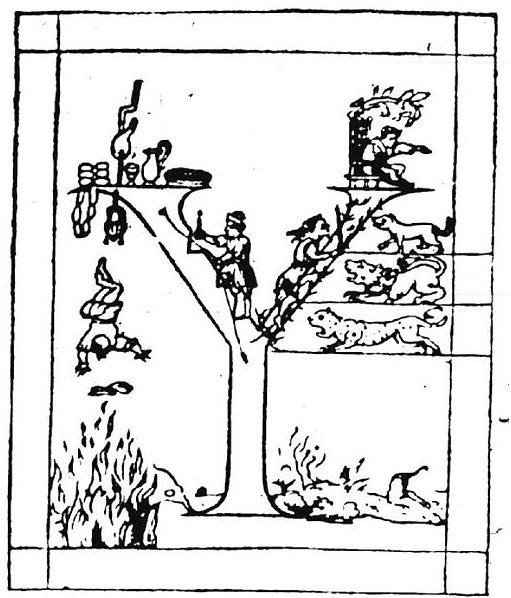I continue:
There were
5 days from Al Minhar al Asad to Ukdah (ι
Hydrae) and then 3 days assigned for the Head of the Lion:
 |
 |
|
Ga3-17 |
Ga3-18 |
|
no
star listed (140) |
Markab Velorum (141.5),
Al Minhar al Asad
(141.6) |
|
August 8 (*140) |
9 |
|
ºAugust 4 (216) |
5
(*137) |
|
'July 12 (193) |
13 |
|
"June 28 |
29
(180) |
|
Dai (323.5), β
Equulei (323.8) |
γ Pavonis (324.1),
Yan (324.6) |
|
February 7 |
8
(*324) |
|
ºFebruary 3 (399) |
4 (*320) |
|
'January 11 |
12
(377) |
|
"December 28 |
29 |
 |
 |
 |
 |
|
Ga3-19 (78) |
Ga3-20 |
Ga3-21 |
Ga3-22 |
|
Star-25 /
ANA-HEU-HEU-PO |
Al
Tarf-7 |
A Hydrae
(144.1)
VEGA
|
Ukdah
(145.4),
κ
Hydrae (145.5), Subra (145.8) |
|
ALPHARD
(142.3),
ω Leonis (142.6),
τ¹ Hydrae
(142.7) |
ψ
Velorum (143.3),
ALTERF,
τ² Hydrae
(143.4), ξ
Leonis
(143.5) |
|
The Knot (Ukdah) |
|
August 10 (222) |
11 |
12
(*144) |
13
(225) |
|
ºAugust 6 |
7
(*139) |
8
(220) |
9 |
|
'July 14 (*115) |
15
(196) |
16 |
17 (*118) |
|
"June 30 (*101) |
"July 1 (182) |
2 |
3 (*104) |
|
Al Sa'd al Su'ud-22 /
Emptiness-11 |
no star listed (326) |
Castra (327.2),
Bunda (327.5)
SIRIUS
|
Nashira (328.0),
Azelfafage, κ Capricorni (328.7) |
|
Tsin (325.2),
Alphirk (325.7), SADALSUD
(325.9) |
|
February 9 (40) |
10 (406) |
11 |
12 |
|
ºFebr 5 (36) |
6
(*322) |
7 |
8
(404) |
|
13
(378) |
14 |
15
(*300) |
16 |
|
30
(364) |
31 (*285) |
"January 1 (366) |
2 |
 |
 |
 |
|
Ga3-23 |
Ga3-24 |
Ga4-1 (84) |
|
ψ
Leonis (146.4),
Ras Elaset Australis
(146.6) |
Vathorz Prior
(147.9) |
υ¹
Hydrae (148.4),
Ras Elaset Borealis
(148.7) |
|
August 14 |
15
(227) |
16 |
|
ºAugust 10 (222) |
11 |
12
(*144) |
|
'July 18 |
19
(200) |
20
(*121) |
|
"July 4 (185) |
5 |
6
(*107) |
|
Enif, Erakis
(329.2), 46 Capricorni, Jih (329.3), ι Piscis
Austrini (329.4), λ Capricorni (329.6), ν Cephei
(329.7), Deneb Algiedi (329.8) |
θ Piscis Austrini
(330.1) |
Kuh (331.4) |
|
February 13 (*329) |
14 |
15
(46) |
|
ºFebruary 9 (40) |
10
(*326) |
11
(407) |
|
'January 17 |
18 (383) |
19
(384) |
|
"January 3 |
4 |
5
(370) |
In
rongorongo times the central position of the Lion's Head was rising
with the Sun in August 15, i.e. in day 227 (possible to allude to
π by way of 22 / 7). In the times of
Al Sharatain this was day 200.
Vathorz Prior is υ Carinae,
marked with number 365 in my astronomy book:

According
to Hevelius this was where Argo Navis rammed the Oak = Robur
Caroli(num):
.jpg)
...
Robur Carolinum,
Charles' Oak, the Quercia of Italy and the
Karlseiche of Germany, was formally published by Halley in 1679
in commemoration of the Royal Oak of his patron, Charles II, in
which the king had lain hidden for twenty-four hours after his
defeat by Cromwell in the battle of Worcester, on the 3rd of
September 1651.
Perhaps the 'Meeting Place of the Dangerous One',
Te Tingaanga O Te Hereke, was here:
| Here
1. To catch eels in a snare of
sliding knots; pole used in this manner of fishing,
with a perforation for the line. 2. To tie, to
fasten, to lash; rasp made of a piece of obsidian
with one rough side; cable, tie; figuratively: pact,
treatise. Vanaga.
1. To lash, to belay, to knot the
end of a cord, to lace, to tie, to fasten, to knot;
to catch in a noose, to strangle, to garrote;
here pepe, to saddle; moa herea, a
trussed fowl; hehere, collar, necklet;
herega, bond, ligament; heregao, scarf,
cravat. 2. Hakahere. To buy, to sell, to
barter, to part with, to pay for, to do business, to
compensate, to owe, to disburse, to expiate, to
indemnify, to rent out, to hire, to traffic, to
bargain, to bribe; merchant, trader, business,
revenge; tagata hakahere, merchant, trader;
hakahere ki te ika, to avenge; hakaherega,
ransom, redemption; hakahererua, to exchange,
to avenge. 3. Here ei hoiho, incense.
Churchill.
Hereke, festering wound,
cracked skin. Barthel 2. |
| |
|
Phoenician waw |
 |
Greek
upsilon |
Υ(υ) |
|
...
Upsilon (uppercase Υ, lowercase υ;
Greek: ύψιλον, ıpsilon ... is the 20th
letter of the Greek alphabet. In the
system of Greek numerals, Υ has a value
of 400. It is derived from the
Phoenician waw ... Waw (wāw
'hook') is the sixth letter of the
Semitic abjads ...
... Upsilon is known as
Pythagoras' letter, or the Samian
letter, because Pythagoras used it as an
emblem of the path of virtue or vice. As
the Roman writer Persius wrote in
Satire III:
and the letter which spreads out into
Pythagorean branches has pointed out to
you the steep path which rises on the
right.
Lactantius, an early Christian author
(ca. 240 - ca. 320), refers to this:
For they say that the course of human
life resembles the letter Y, because
every one of men, when he has reached
the threshold of early youth, and has
arrived at the place 'where the way
divides itself into two parts', is in
doubt, and hesitates, and does not know
to which side he should rather turn
himself´...
 |
|





.jpg)
